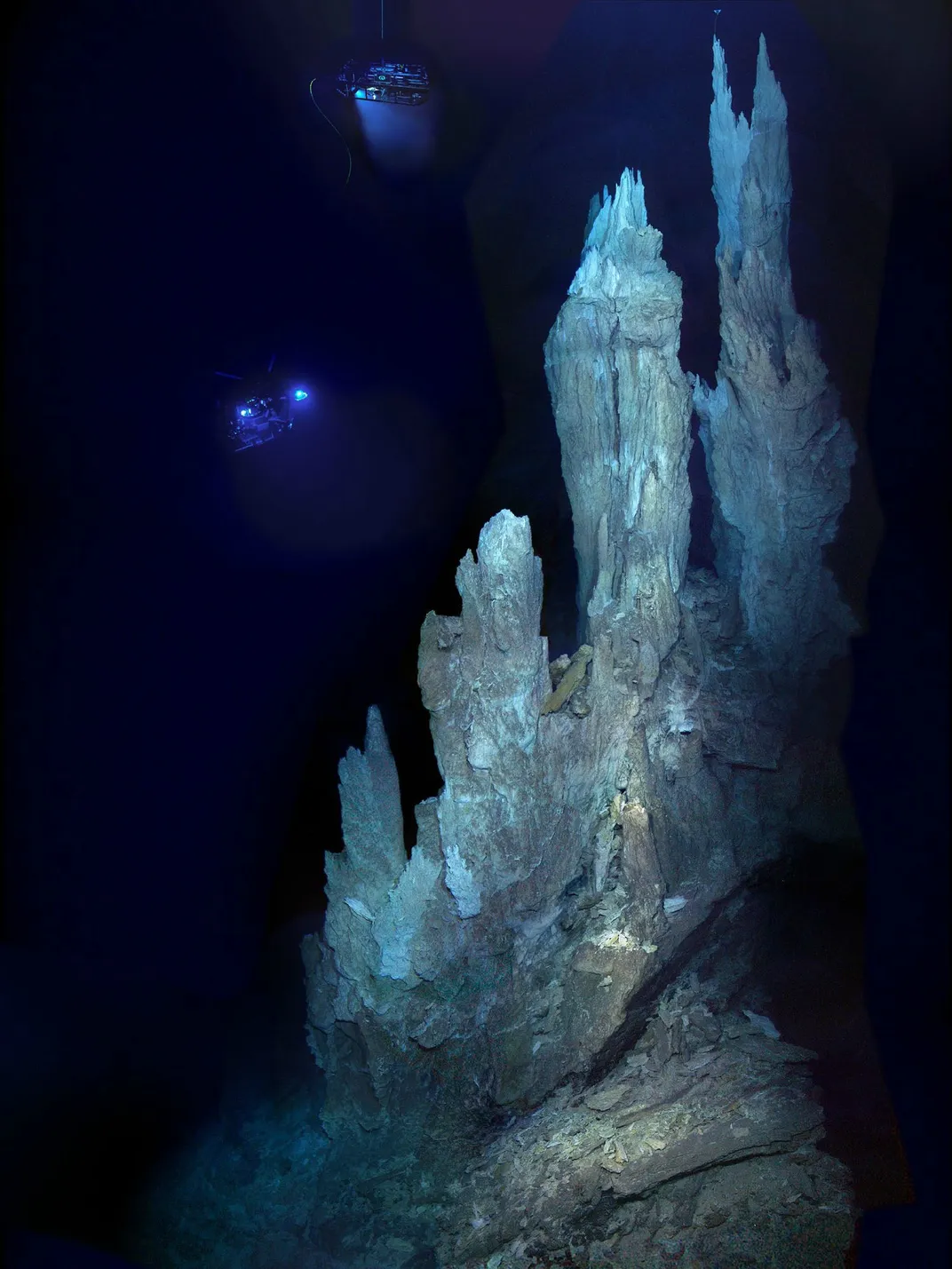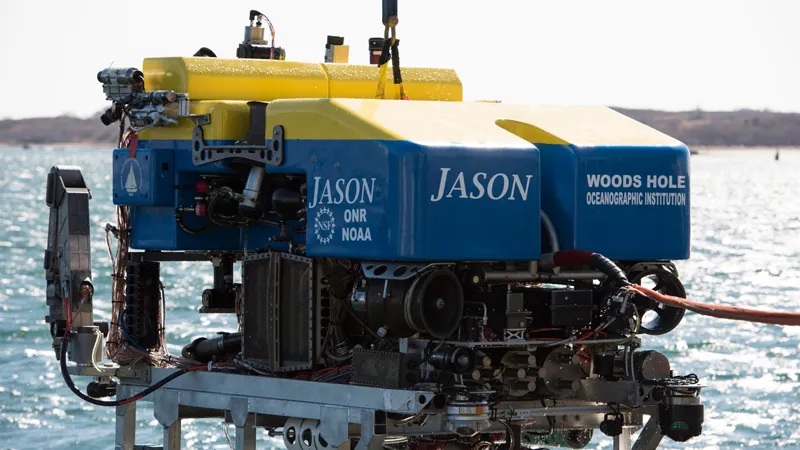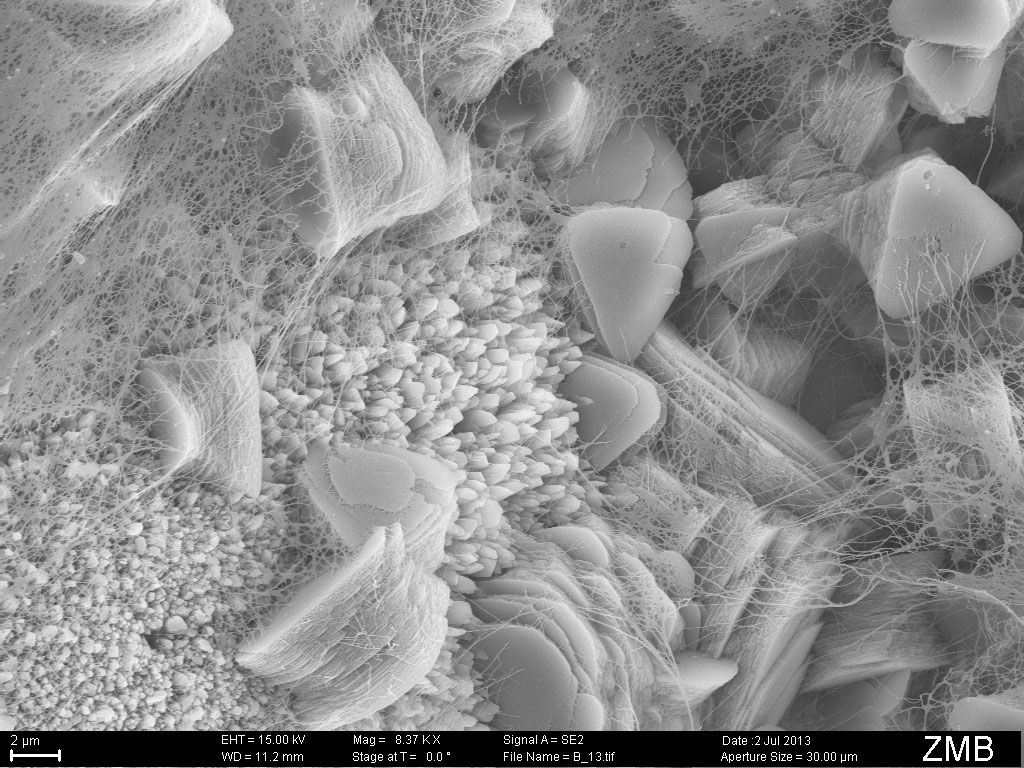Diving Deep to Reveal the Microbial Mysteries of Lost City
An expedition sets out this week to explore a field of hydrothermal vents in the deep Atlantic, one of the most extreme ecosystems on the planet
:focal(620x520:621x521)/https://tf-cmsv2-smithsonianmag-media.s3.amazonaws.com/filer/81/fb/81fb9716-e887-4102-94ec-b8bc726d1beb/herculesimax.jpg)
Smack in the middle of the Atlantic Ocean, atop an underwater mountain rising over 10,000 feet above the seafloor, sits Lost City. Hundreds of white spires jut into the dark ocean, spanning the area of a city block and towering between 30 and 200 feet tall. Hot alkaline fluids filled with hydrogen gas spew from the tops of these natural towers into the waters just east of the Mid-Atlantic Ridge.
What looks like a long-abandoned metropolis is, in fact, teeming with microscopic life. The trillions of microbial residents of Lost City, perched on top of the Atlantis Massif, have become a fascination for scientists. These microbes, thriving in a hydrothermal vent field deep in the Atlantic, hold the secret to life’s survival in such hostile environments—and they may even provide clues about the origins of life on Earth.
Tomorrow, September 8, a group of 22 researchers, microbiologists, geologists and oceanographers, will travel to Lost City for the first time in years. This group of scientists wants to know how the microbes of Lost City make their living, what they eat and breathe, and how they survive in the extreme temperatures and pressures of the deep ocean.
“We want to know how they’re living there,” says team co-lead William Brazelton, a microbiologist at the University of Utah.
Discovered in 2000, Lost City is one of only a few known places like it on the planet. Unlike more common types of hydrothermal vents, such as black smokers and methane seeps, Lost City is not fueled by volcanic activity. Rather, the vents are created when seawater encounters rock from the Earth’s mantle, creating gas and energy in a process known as serpentinization. Calcium-rich water from these vents then reacts with carbon in the seawater to form Lost City’s iconic carbonate chimneys.

Hydrogen gas spewing from the chimneys provides an ample energy source for the microbes living in Lost City. “It’s the closest thing to a free lunch the universe provides,” Brazelton says. The chimneys also release methane, an organic molecule which is a rich source of energy for many types of life.
While energy is abundant, it’s not yet clear where microbes in this deep-sea ecosystem get their carbon or nutrients. According to team co-lead Susan Lang, a geochemist at the University of South Carolina, solving this mystery is one of the primary missions of the expedition.
“One of the questions we’re trying to go after is, what are these microbes scrounging for?” she says. “Life is always scrounging for something.”
During the three-week expedition, scientists aboard the U.S. Navy research vessel (R/V) Atlantis will send a remotely operated vehicle (ROV), named Jason, down some 2,600 feet into Lost City to collect samples. “Jason looks like an SUV with a big tail coming out of the back,” says Beth Orcutt, a microbiologist at the Bigelow Laboratory for Ocean Sciences, who is involved in the expedition but not going herself. “The scientists use Jason as their eyes and arms on the seafloor.”
Jason will collect sediment from the seafloor and extract small samples of Lost City chimneys, but mostly, Jason will be collecting water. The expedition scientists plan to collect water streaming out of the chimneys to capture microbes that live deep within the Atlantis Massif. The researchers hypothesize that microbes within the mountain introduce carbon and nutrients to the ecosystem, which enables microbial life on the surface of the chimneys.
“It would show that the earth is a highly connected system,” Lang says. “Even really weird organisms living down at the sub-seafloor are enabling life on the surface.”

Determining how microbes survive within the mountain, where inhospitable conditions surround the serpentinization process, could also give a glimpse of possible life on other planets. Because the ingredients are relatively simple (rock and seawater), and the environment is oxygen-free, microbes within the Atlantis could be a window to extraterrestrial lifeforms.
“This is an example of a type of ecosystem that could be active on Enceladus or Europa right this second,” Brazelton said, referring to watery moons of Saturn and Jupiter, “and maybe Mars in the past.”
The ROV Jason will collect around 30 liters of seawater every day. Some of the collected water will be stored in freezers for future research, while some will be analyzed on the spot to measure chemical composition as well as microbe and virus populations. Over the next years, genetic testing of the seawater samples will illuminate what kinds of microbes live in this extreme environment and how they manage to survive.
There are also scientists who believe that Lost City, or a place like it, may be where life started on Earth. “It’s a good system for where early life may have developed,” Lang said. Small pores in the walls of Lost City chimneys, combined with basic (as opposed to acidic) seawater and an unlimited energy source in the hydrogen gas, could provide the Goldilocks conditions needed for spontaneous life.
“The geochemistry and geology at Lost City appear to come together in a way that would resolve the energetic chicken-and-egg problem of life’s origin,” said Jeffrey Marlow, a microbiologist at Harvard University who is not involved in the expedition. The “chicken-and-egg” problem refers to the fact that a cell needs energy to create bio-molecules, and bio-molecules are needed to harness energy.
Marlow thinks it’s plausible that the high-pH water swirling into chimney pores at Lost City could generate favorable conditions for life to begin. The hydrogen gas and other molecules mixing together in the pores may create a pre-cursor to a cell, known as a proto-cell.

Other places like Lost City exist in the deep sea, but they have proven difficult to find. Because the byproducts of serpentinization are relatively mundane—mostly hydrogen and methane—sites like Lost City don’t have strong biosignatures like other hydrothermal vent systems, such as black smokers which spout sulfur gas. “We would posit that sites like Lost City are pretty widespread, we just don’t know where they are,” Lang says. “Right now, we would say Lost City is unique, but it’s probably not alone.”
Finding another Lost City soon seems unlikely considering most of the ocean has never been explored by humans. “We’ve only seen a tiny fraction of the seafloor,” Marlow says. “There’s so much more out there to be discovered.” According to the United States National Ocean Service, less than 20 percent of the ocean has been mapped or observed by humans.
The deep ocean is as much a frontier for scientists as deep space. Researchers are just beginning to understand how diverse life functions in extreme ecosystems near the seafloor, and scientists aren’t the only ones looking to the deep sea. Mineral resources, like nickel, cobalt, silver and gold, have piqued the interest of mining companies, who are increasingly investing in future deep-sea exploitation.
“When I was a student learning about the deep sea, the idea that there are minerals on the seafloor that industries might want to mine was totally a sci-fi idea because it was not economically viable at all,” Orcutt said. But now, the required technologies are here, and the International Seabed Authority (the United Nations agency that gives permission for mining in international waters) gives out permits for mining exploration every year. One such permit, issued in August 2017, gave Poland the right to exploit the area of seafloor where Lost City is located.
/https://tf-cmsv2-smithsonianmag-media.s3.amazonaws.com/filer/e2/23/e2230b6b-bef4-41f2-938b-fad047045ba3/lost_city_beehive.jpg)
Some marine scientists say that mining the seafloor before we understand its basic biology could be a recipe for disaster. “Just like with any frontier, it’s pretty easy to affect changes without even knowing what’s there or what the vulnerabilities are,” says Lisa Levin, a deep sea biologist and co-founder of the Deep Ocean Stewardship Initiative, which aims to bring scientists, economists, policy experts and industry representatives together on issues of deep sea exploitation. Levin says that when Poland received the rights to mine the area around Lost City, it raised a red flag for deep sea microbiologists. “It was a catalytic event.”
Many deep-sea researchers are now calling to conserve Lost City and places like it, highlighting the global importance of deep ocean microbiology, which contributes to nutrient cycles, climate mitigation and genetic diversity. “We want to draw attention to the invisible fraction of life,” Orcutt says, who has organized scientific meetings about the impacts of deep sea mining on microbial activity. “The sea floor has value. Every time scientists go to the bottom of the ocean, new species are discovered. There’s so much of the ocean we don’t know about.”
This month’s expedition to Lost City will help us learn a little bit more about the mysterious worlds below.